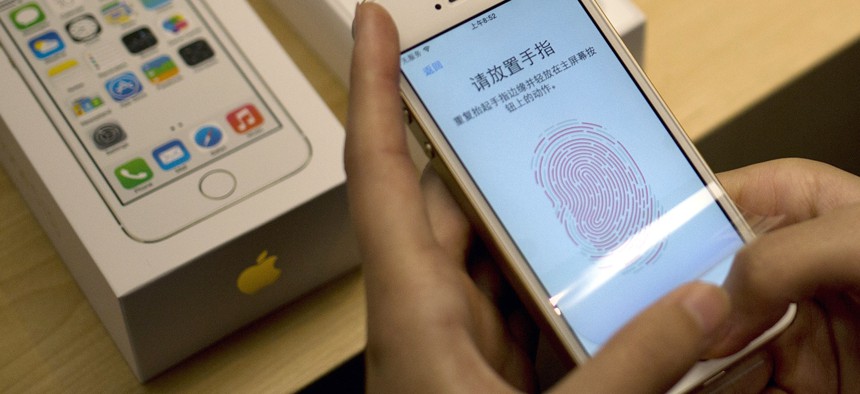
In this Sept. 20, 2013 file photo, a customer configures the fingerprint scanner technology built into the Apple iPhone 5S at an Apple store in Wangfujing shopping district in Beijing. Andy Wong/AP
So That Thumbprint Thing on Your Phone Is Useless Now
Researchers found a cheap, easy way to copy your fingerprints a few months after millions of Americans had theirs stolen by hackers.
Last year, when the Office of Personnel Management notified 22 million people that their personal information was compromised in a massive data breach, one in four received especially nasty news. For most hack victims, the sensitive personal data that was exposed included Social Security numbers, health and financial records, names of relatives, and past addresses. But 5.6 million people learned that their fingerprints were also stolen.
At the time of the announcement, OPM downplayed the importance of the stolen fingerprints. “Federal experts believe that, as of now, the ability to misuse fingerprint data is limited,” an OPM statement read. “However, this probability could change over time as technology evolves.”
That was in September. Now, researchers have developed a cheap and easy way to print out an image of a fingerprint with enough accuracy to fool commercially available fingerprint readers—using just a standard inkjet printer.
The method, outlined in a paper published last month, is certainly not the first one to produce fake fingerprints that are able to fool readers. But where earlier methods required more time and specialized materials, this new method is replicable in just about any home office.
Related: China Is Watching the FBI-Apple Battle Very Closely
Related: FBI Head: Apple is Taking Us To a ‘Different World’
To create a working copy of a fingerprint, the study authors—Kai Cao and Anil Jain, both researchers at Michigan State University—started by installing special ink cartridges and paper in a Brother inkjet printer. Both materials came from a Japanese company called AgIC: The ink can conduct electricity when printed on the specialized paper, effectively creating a printed circuit. The researchers scanned a fingerprint in high resolution, mirrored it, and printed it with the retrofitted inkjet.
The researchers placed the fake, printed fingerprint on the fingerprint readers of two popular Android phones, a Samsung Galaxy S6 and a Huawei Hornor 7. Both phones were set up to unlock with the owner’s real fingerprint—but the fake version of the same finger fooled them. (Cao told Quartz that he had mixed results when using an iPhone.)
The easy fingerprint-spoofing method is particularly worrisome in the context of the OPM breach. After all, prints aren’t just useful for unlocking smartphones—they can also be used to authorize financial transactions, from small Apple Pay purchases to large bank transfers. And, of course, once a fingerprint has been compromised, there’s no resetting it the way you can change a password—short of a thumb transplant.
The simplicity and speed of the new fingerprint-spoofing method makes it easy to copy a lot of fingerprints fast, Cao told me in an email. His method is remarkable because the fake fingerprints are two-dimensional—earlier techniques required raising the ridges of a fake fingerprint with latex or wood glue.
Fingerprint-copying enthusiasts following along at home can get started for cheap. Everything you need to create a paper version of your (or someone else’s) fingerprint can be shipped to your door for less than $450.
For the millions of OPM hack victims who had their fingerprint data compromised, that’s unhappy news. Until everyday fingerprint readers advance to the point that they can discern between a human hand and a printout, they may want to start unlocking their smartphones the old-fashioned way.




